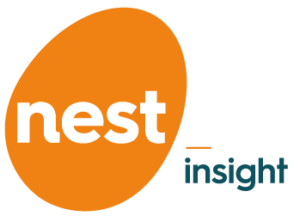Read the report: Employer pension contributions in the UK: the current landscape and the potential for innovation (PDF)
New research published today by Nest Insight reveals what employer pension contributions are currently being offered, to which employees and why, across different sizes and types of employers. This new project, supported by abrdn Financial Fairness Trust, also examines employers’ appetite to make changes and to innovate towards improving employees’ financial security in retirement.
Legal minimum contribution levels are acting as strong defaults
- 4 in 10 employees work for an organisation offering the minimum 3% employer contribution to all their workers, and a further 2 in 10 employees work for an employer that offers the minimum contribution to some of their employees.
Of employers who offer only the minimum contribution to all employees, around half (51%) said this is because they cannot afford to contribute more than this, and around a quarter (26%) said they do so because they are prioritising putting money into base salaries.
The research findings also suggest that the minimum contribution levels are acting as a strong default. Of the organisations offering the minimum employer contribution to all of their employees:
- Nearly 1 in 3 said they do this because they believe it is the amount recommended by government.
- 1 in 5 said they were driven by the default settings in their payroll software or pension provider set up.
- 1 in 20 said that they did not know it was possible for an employer to contribute more than 3%.
Many employers offer above-minimum employer contributions, but these are often not directed to those who may be most in need
- 4 in 10 employees work for an organisation offering more than the 3% minimum employer contribution to all of their employees.
- Around 4 in 10 employees work for an employer that calculates pension contributions on all earnings, not just the minimum required band of qualifying earnings.
Auto enrolment has significantly equalised access to workplace pension saving and to employer contributions by lifting the floor for all workers, but access to higher-than-minimum contributions is not evenly distributed:
- Around half of large employers offer more than the minimum, compared to a quarter of small organisations.
- Employers are more likely to offer above-minimum contributions if they predominantly have employees that are:
– Salaried
– Higher earners
– Highly skilled
– Long-tenure.
Current approaches were also found to often direct any higher-than-minimum employer contributions to employees who can afford to contribute more, are likely to have greater financial security and be more financially confident:
- Half of employees work for an employer that offers matched contributions to some or all their employees when they pay more in, and around 1 in 3 employees work for an employer that offers this to all employees.
- 3 in 5 employers who offer higher than minimum contributions to some of their employees, report seniority as the top factor behind the approach.
Employers see very limited opportunity to voluntarily increase their contributions rates but show interest in innovations
The current challenging economic context, the inflexibility of legacy systems and the complexity of some employers’ pension provision all act as strong barriers, even when employers would like to make changes.
- Nearly 2 in 3 employers say that their organisation is unlikely to voluntarily implement a different approach to pensions contributions in the next two to five years. This rises to 3 in 4 among smaller employers.
Employers are most interested in innovations that help employees to contribute more without necessarily requiring higher contributions from themselves, including:
- Salary sacrifice: 2 in 3 employers thought a salary sacrifice approach was appealing in which tax savings could potentially be added to pension contributions to boost the employee’s retirement saving.
- Auto escalation: 5 in 10 employers liked the idea of an auto escalation approach in which an employee can commit now to automatically increasing their pension contribution in future, for example when they get a pay rise or after a year.
- Hybrid approaches: Around 4 in 10 employers thought combining pension saving and other forms of saving was appealing, for example a hybrid ‘sidecar saving’ model where employees build up a pot of liquid emergency savings alongside their retirement savings.
- Higher default with the option to opt down: Around 1 in 3 employers found this approach attractive. In this model, employees could choose to opt down to minimum contributions from a higher default, rather than them having to opt in to making higher contributions.
Few employers actively consider employee retirement adequacy when setting their pension contribution levels
Only 6% of employers who offer more than minimum contributions for some or all of their employees say that the levels set were driven by modelling retirement outcomes or considering salary replacement rates for their employees.
Retirement outcomes are seen by most employers to be mainly the employee’s responsibility
60% of employers consider the employee to be the most responsible for ensuring they have a financially secure retirement, 20% said the government was most responsible and only 13% that the employer was most responsible. Employers often feel that their impact on employee retirement outcomes is minimal when employees have multiple jobs over their working life.
A fundamental divide in employer opinion underpinning differences in approaches
In those cases where employers may consider doing more, there is an interesting range of views on how to target that support.
- Whilst around 1 in 3 employers said equality would be a top priority if they were to implement a new pension contributions approach,
- around 1 in 5 said that boosting retirement saving for those on the lowest incomes would be a top priority; and
- a similar proportion (1 in 5) said that contributing more for those who are most engaged with retirement saving would be a top priority.
Jo Phillips, Director of Research and Innovation at Nest Insight, comments:
“Auto enrolment was a huge undertaking for many employers. It’s a great achievement and a good equalisation story. As we look to the future, the focus is now on how to support employees to save enough to achieve financial security in retirement. Given the current economic context, it’s not surprising that employers are most interested in innovations that help their employees to contribute more without requiring higher contributions from themselves. This, of course, contrasts with the current policy debate around employer contributions which focuses on re-balancing default minimum contribution rates, often calling for a move to an equal balance of 6% and 6% from the current 3% employer and 5% employee levels.
“Without policy change, it’s unlikely that most employers will actively set out to re-evaluate their pension contributions approach in the near future. There are, however, pockets of opportunity, in particular where an employer can support their employees to save more for retirement at little or no extra cost to the organisation, or where there is also a benefit for the employer such as with a salary sacrifice approach.
“Auto-escalation of employee contributions was one of the most attractive ideas among employers, as was the approach of setting the default for the employee contributions higher with the right to opt down. While these mechanisms move further from the ‘equal contributions’ goal of some policy recommendations, they may well be appropriate for many workers, particularly those with low or moderate incomes. We were also interested to see the appetite among employers for supporting shorter-term savings. Structures that support some balance for workers between higher pension contributions and some additional more accessible saving may similarly represent an attractive way through.”
Karen Barker, Head of Policy and Research at abrdn Financial Fairness Trust, said:
“Too many of us are not saving enough towards our pensions to ensure financial security in retirement. While it is understandable that both employers and their employees are currently more focussed on getting through the current cost-of-living crisis rather than prioritising pension saving, we must be careful that immediate needs don’t come at the expense of people’s living standards for decades in later life.
“This report demonstrates that even now there are affordable actions many employers can take to support their employees to increase their pension savings.
“This analysis also shows marked inequalities in who benefits the most from existing schemes which will need to be addressed by employers and policy makers over the long-term to ensure that working for a smaller company or earning a lower salary doesn’t leave a liveable pension out of reach.”
ENDS
Notes to editors
About this research
The research included 30 in-depth interviews with UK employers, their advisors and industry bodies, as well as a nationally representative online survey conducted in March and April 2022 with 500 UK employer pension decision makers.
The research data has been weighted to be representative of employers based on their contribution to employment, rather than the incidence of that size of employer in the total business population. It has also been weighted to reflect industry and region.
For further information about the research methodology, please see page 18-23: Employer pension contributions in the UK: the current landscape and the potential for innovation (PDF)
About Nest Insight

Nest Insight is a public-benefit research and innovation centre. Our mission is to find ways to support people to be financially secure, both today and into retirement. We conduct rigorous, cutting-edge research, working collaboratively with industry and academic partners to understand the financial challenges facing low- and moderate-income households. We use these data-driven insights to identify and test practical, real-world solutions. Our findings are shared widely and freely so that people around the world can benefit from our work. For more information visit nestinsight.org.uk
About our programme partner
![]()
abrdn Financial Fairness Trust funds research, policy work and campaigning activities to tackle financial problems and improve living standards for people on low-to-middle incomes in the UK. It is an independent charitable trust registered in Scotland (SC040877). For more information, visit: financialfairness.org.uk
About Nest Insight’s strategic partners
![]()
BlackRock is a global investment manager serving the UK market for more than 30 years with a purpose to help more and more people experience financial well-being. BlackRock’s Emergency Savings Initiative is made possible through philanthropic support from the BlackRock Foundation. The initiative brings together partner companies and nonprofit financial health experts to make saving easier and more accessible for low- to moderate-income people across the US and UK, ultimately helping more people to establish an important financial safety net. For more information, visit blackrock.com/corporate/about-us/social-impact
![]()
Invesco is an independent investment management firm dedicated to delivering an investment experience that helps people get more out of life. Building on its strong track record in defined contribution research, and its existing partnership with the University of Cambridge Judge Business School, Invesco partnered with Nest Insight to support their ambitious programme of research, publications and events. For more information visit invesco.co.uk NYSE: IVZ







